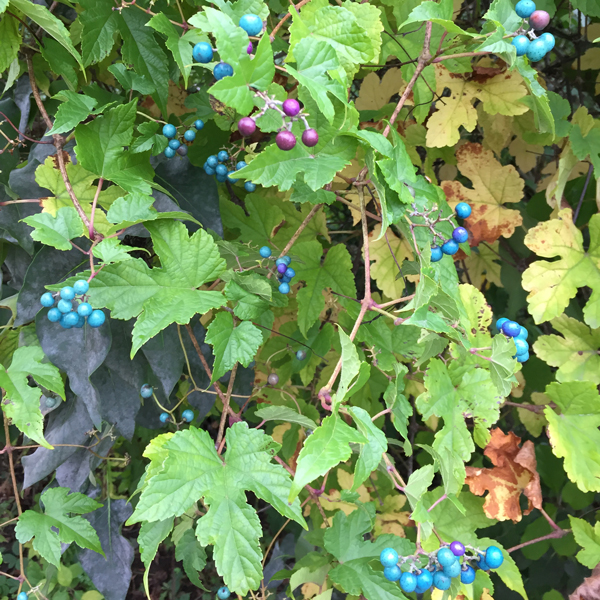As autumn begins the celebration of its journey toward winter, two notable vines with brightly-colored fruit attract our attention: oriental bittersweet (Celastrus orbiculatus) and porcelain vine (Ampelopsis brevipedunculata), both introduced to the USA many years ago from eastern Asia. As spectacularly appealing as these two plants may be to the eye, they are invasive and not a welcome addition to your yard. Both are greedy growers that aggressively clamber up and over desirable trees and shrubs, shading-out sunlight, choking, and sometimes even pulling-down branches. And they’re not easy to control.
Seedlings of bittersweet germinate readily, even in shady conditions. Their rounded leaves emerge early in spring along rapidly-growing stems that reach out and seek nearby trees, shrubs or any support to use as a scaffold. They wind firmly around their host, actively climbing toward the light. Often inconspicuous when young among the branches of their supporting plants, uncontrolled older vines can eventually grow to 60+ ft. long with stems 2 inches or more in diameter.
Bittersweet’s orange-red berries have become a familiar sight almost everywhere, their cut fruiting branches historically enjoyed as part of Halloween and Thanksgiving holiday décor (please don’t do that!). Yellow bittersweet pods appear in early autumn, waiting until closer to the first frost to open and reveal the orange-red fruit inside. Their visual appeal lasts for many weeks until taken by hungry animals or a hard freeze causes them to drop.
Porcelain vine is not as commonly seen in this region (yet!). During the summer and other seasons, distinguishing porcelain vines from native grapevines can be challenging: both are deciduous woody vines in the Vitis family with similar-looking leaves; each can grow 15 ft. or more in a single season; stems and leaf stalks on both vines vigorously twine-around any support and use tendrils. But there’s no identity question when their fruit appears. Few displays can rival the unique, shiny, upright clusters of quarter-inch pink, lavender, turquoise, and blueberries that brilliantly adorn porcelain vine every fall.
Another common name for the porcelain vine is Amur peppervine, aptly describing the appearance of its pepper-like berries—questionably edible for humans, but well-appreciated and readily dispersed by birds and animals. Adding to its visual appeal, a variegated-leaf form is often seen and was formerly sold by many nurseries (including ours), unaware of its invasive propensity (Ampelopsis brevipedunculata ‘Elegans’, making its scientific name an even bigger mouthful!).
Control of both oriental bittersweet and porcelain vines can be a major undertaking. Simply applying herbicide to foliage is usually ineffective and not recommended. Preventing seed from forming is fundamental to reducing dispersion, so cutting-back vines in summer both reduces the opportunity for seed to form and also releases host plants underneath. Once the source of the vine is found, spading out the root system or applying herbicide directly to stems cut near the ground is the best control method. Unfortunately, because both vines tend to regrow from underground roots (bittersweet roots are bright orange) that break off when dug or are not controlled by herbicide, the process should be repeated every year.







